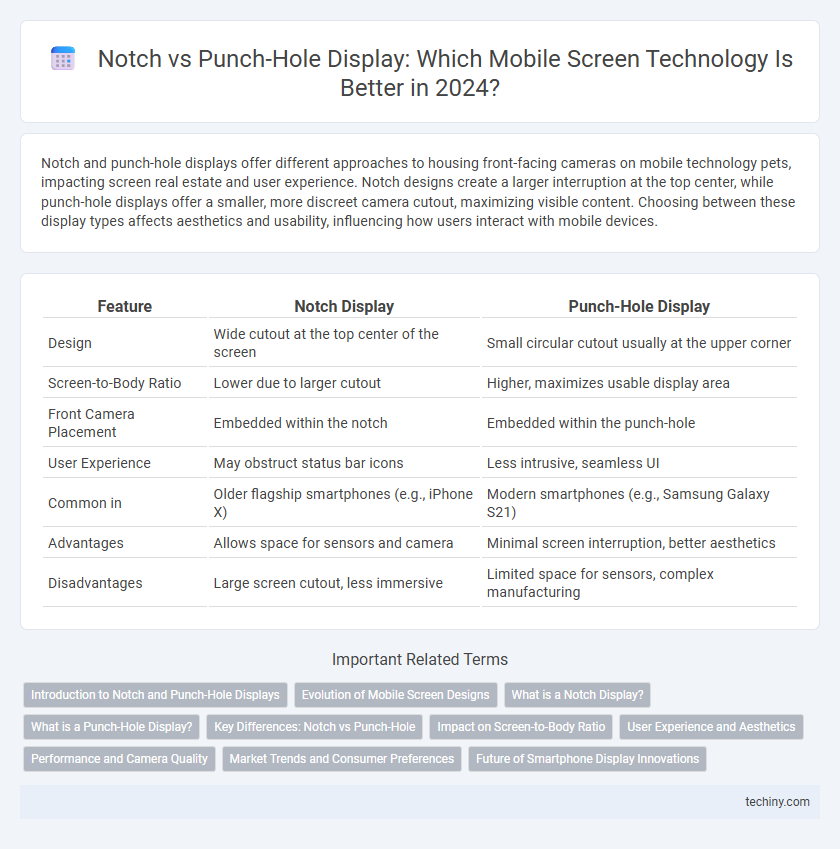Notch and punch-hole displays offer different approaches to housing front-facing cameras on mobile technology pets, impacting screen real estate and user experience. Notch designs create a larger interruption at the top center, while punch-hole displays offer a smaller, more discreet camera cutout, maximizing visible content. Choosing between these display types affects aesthetics and usability, influencing how users interact with mobile devices.
Table of Comparison
| Feature | Notch Display | Punch-Hole Display |
|---|---|---|
| Design | Wide cutout at the top center of the screen | Small circular cutout usually at the upper corner |
| Screen-to-Body Ratio | Lower due to larger cutout | Higher, maximizes usable display area |
| Front Camera Placement | Embedded within the notch | Embedded within the punch-hole |
| User Experience | May obstruct status bar icons | Less intrusive, seamless UI |
| Common in | Older flagship smartphones (e.g., iPhone X) | Modern smartphones (e.g., Samsung Galaxy S21) |
| Advantages | Allows space for sensors and camera | Minimal screen interruption, better aesthetics |
| Disadvantages | Large screen cutout, less immersive | Limited space for sensors, complex manufacturing |
Introduction to Notch and Punch-Hole Displays
Notch and punch-hole displays represent two popular front camera designs in mobile technology, maximizing screen real estate by minimizing bezel space. The notch typically spans a wider area at the top of the screen, housing sensors and the front camera in a cutout, while punch-hole displays feature a small, circular cutout that encroaches less on the display area. Both designs aim to enhance user experience by delivering larger, uninterrupted screens without sacrificing front-facing camera functionality.
Evolution of Mobile Screen Designs
Mobile screen designs evolved from prominent notches housing front cameras and sensors to more refined punch-hole displays that maximize screen real estate and enhance user experience. Punch-hole displays, introduced by brands like Samsung and Huawei, offer a minimalist aesthetic by embedding the camera within the screen itself, improving immersive viewing. This transition reflects the industry's focus on seamless edge-to-edge displays, higher screen-to-body ratios, and advanced under-display sensor technologies.
What is a Notch Display?
A notch display features a cutout at the top of the screen to house the front camera and sensors, maximizing screen real estate while maintaining essential functionalities. Notch designs vary in size and style, ranging from wide rectangular shapes to smaller teardrop forms, optimizing the balance between display area and hardware placement. This design emerged as a popular solution for bezel-less smartphones, enabling larger screens without increasing device size.
What is a Punch-Hole Display?
A punch-hole display features a small, circular cutout within the screen that houses the front-facing camera, maximizing usable screen space compared to traditional bezels or large notches. This design enhances immersive viewing experiences by minimizing obstruction and enabling higher screen-to-body ratios in smartphones. Manufacturers implement punch-hole displays to balance aesthetic appeal with functional front-camera placement in modern mobile technology.
Key Differences: Notch vs Punch-Hole
The key differences between notch and punch-hole displays lie in their design and user experience: notches occupy a larger portion of the screen edge, typically housing multiple sensors and the front camera, while punch-hole displays feature a smaller, circular cutout primarily for the front camera, maximizing screen real estate. Notch designs often disrupt content display more noticeably compared to the subtler punch-hole, which offers a more immersive viewing experience. In terms of aesthetic, punch-hole displays provide a cleaner, modern look preferred in flagship mobile devices with advanced OLED panels.
Impact on Screen-to-Body Ratio
Notch displays reduce screen-to-body ratio by occupying more space at the top of the screen, limiting the usable display area compared to punch-hole designs. Punch-hole displays maximize screen real estate by embedding the front camera within the screen, allowing for higher screen-to-body ratios and a more immersive viewing experience. Manufacturers increasingly favor punch-hole cutouts to enhance display continuity and improve overall device aesthetics.
User Experience and Aesthetics
Notch displays, with their prominent cutouts, offer a distinct visual design but can disrupt immersive content by partially obstructing the screen, affecting user experience during video playback and gaming. Punch-hole displays feature a smaller, more discreet camera cutout, maximizing screen real estate and providing a cleaner, modern aesthetic that enhances viewing without significant distraction. User preference often leans toward punch-hole designs for their balance of functionality and sleek appearance, contributing to a more seamless and visually appealing mobile interface.
Performance and Camera Quality
Notch displays often house advanced facial recognition sensors and multiple cameras, enhancing biometric security and offering superior front-facing photo quality. Punch-hole displays provide a larger screen-to-body ratio, improving immersive viewing experiences without compromising single front camera performance. Both designs impact device aesthetics and user interaction, but camera quality hinges more on sensor technology than display cutout type.
Market Trends and Consumer Preferences
Market trends in mobile technology reveal a growing consumer preference for punch-hole displays due to their minimal screen obstruction and modern aesthetic. Notch designs, while initially popular for housing front cameras and sensors, are increasingly viewed as outdated compared to punch-hole alternatives that offer a more immersive viewing experience. Smartphone manufacturers are shifting towards punch-hole displays to meet demand for sleeker designs and maximize screen real estate.
Future of Smartphone Display Innovations
Notch and punch-hole displays represent early steps in maximizing screen real estate, but future smartphone display innovations will focus on under-display cameras and foldable screen technologies to achieve true edge-to-edge viewing. Advancements in OLED and micro-LED panels promise higher resolution, enhanced brightness, and improved energy efficiency, enabling seamless integration of sensors beneath the display. Emerging developments in transparent and flexible substrates will further revolutionize user interaction by allowing devices to transform shape and form while maintaining display integrity.
Notch vs punch-hole display Infographic

 techiny.com
techiny.com